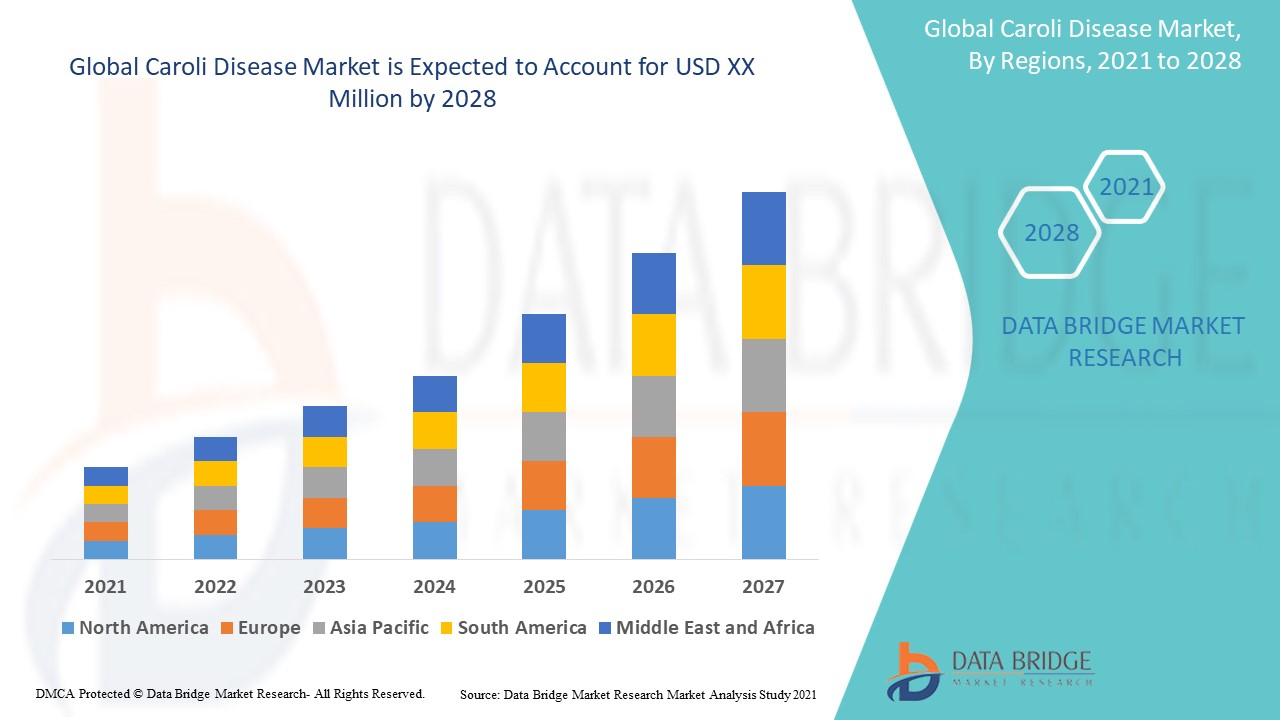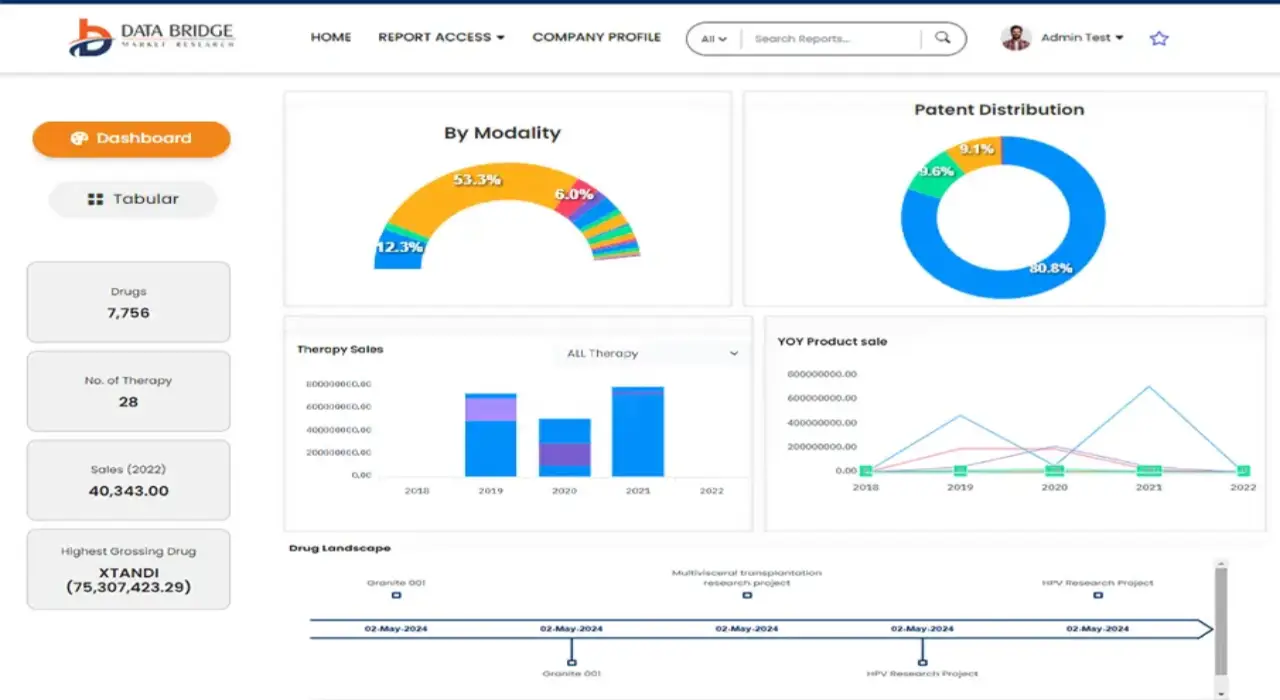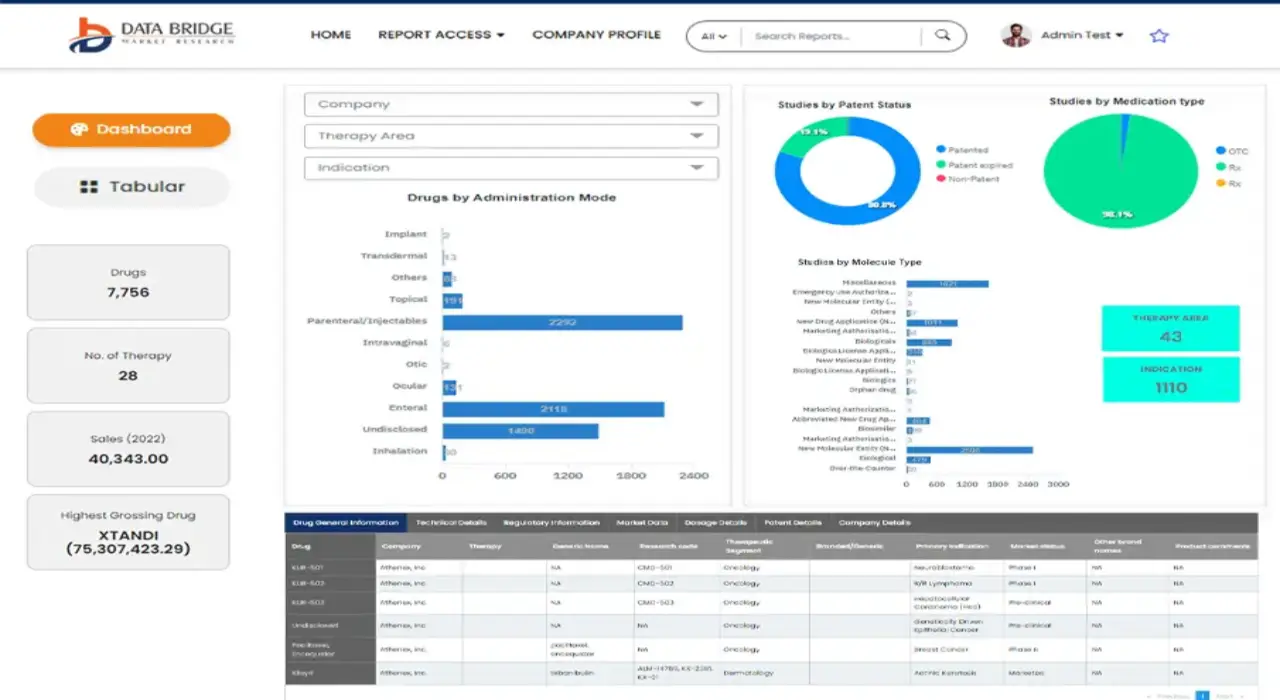Global Caroli Disease Market
Market Size in USD Million
CAGR :
% 
 USD
90.42 Million
USD
200.18 Million
2024
2032
USD
90.42 Million
USD
200.18 Million
2024
2032
| 2025 –2032 | |
| USD 90.42 Million | |
| USD 200.18 Million | |
|
|
|
|
Global Caroli Disease Market Segmentation, By Type (Simple Caroli Disease and Complex Caroli Disease), Treatment (Antibiotic, Ursodeoxycholic Acid, Liver Transplantation, and Others), Diagnosis (Blood Tests, Ultrasounds, Magnetic resonance cholangiography (MRCP), Endoscopic retrograde cholangiopancreatography (ERCP), CT scan, MRI, and Others), Symptoms (Itching, Bacterial Cholangitis, Diarrhea, Right Upper Abdomen Pain, Fever, Liver Fibrosis, Anorexia, Vomiting, Portal Hypertension, and Others), Dosage (Tablet, Injection, and Others), Route of Administration (Oral, Intravenous, and Others), End-Users (Clinic, Hospital, and Others), Distribution Channel (Hospital Pharmacy, Retail Pharmacy, and Online Pharmacy) – Industry Trends and Forecast to 2032
Caroli Disease Market Analysis
The Caroli disease market is witnessing advancements in both diagnostic methods and treatment technologies, driving its growth. One of the significant technological advancements is the development of advanced imaging techniques such as magnetic resonance cholangiopancreatography (MRCP) and elastography. These tools allow for better visualization and assessment of bile duct abnormalities, crucial for diagnosing Caroli disease. In addition, next-generation sequencing (NGS) service and genetic testing have become increasingly important for identifying genetic mutations associated with the disease, allowing for more accurate and personalized diagnoses.
In terms of treatment, there has been progress in developing targeted therapies aimed at managing the complications of Caroli disease, particularly cholangitis and liver fibrosis. The use of specific antifibrotic agents and immunosuppressive drugs is gaining traction, offering potential for better disease management and reduced progression.
The market is expected to grow due to the increasing prevalence of Caroli disease, improved diagnostic tools, and emerging therapeutic options. The rise in awareness, along with ongoing clinical trials for novel therapies, will contribute to the expansion of the Caroli disease market in the coming years.
Caroli Disease Market Size
The global caroli disease market size was valued at USD 90.42 million in 2024 and is projected to reach USD 200.18 million by 2032, with a CAGR of 10.7% during the forecast period of 2025 to 2032. In addition to the insights on market scenarios such as market value, growth rate, segmentation, geographical coverage, and major players, the market reports curated by the Data Bridge Market Research also include depth expert analysis, patient epidemiology, pipeline analysis, pricing analysis, and regulatory framework.
Caroli Disease Market Trends
“Increasing Awareness and Early Diagnosis”
A major trend driving growth in the Caroli disease market is the increasing awareness and early diagnosis of the condition. As awareness about Caroli disease, a rare genetic disorder that affects the bile ducts, rises, more individuals are seeking medical attention and getting diagnosed early. This trend is encouraged by advances in imaging technologies, such as MRI and CT scans, which facilitate accurate diagnosis of the disease in its early stages. Early diagnosis allows for more effective treatment and management, leading to improved patient outcomes. As awareness campaigns increase globally, more individuals are being diagnosed, thereby expanding the market for Caroli disease treatments and care solutions.
Report Scope and Caroli Disease Market Segmentation
|
Attributes |
Caroli Disease Key Market Insights |
|
Segments Covered |
|
|
Countries Covered |
U.S., Canada and Mexico in North America, Germany, France, U.K., Netherlands, Switzerland, Belgium, Russia, Italy, Spain, Turkey, Rest of Europe in Europe, China, Japan, India, South Korea, Singapore, Malaysia, Australia, Thailand, Indonesia, Philippines, Rest of Asia-Pacific (APAC) in the Asia-Pacific (APAC), Saudi Arabia, U.A.E, South Africa, Egypt, Israel, Rest of Middle East and Africa (MEA) as a part of Middle East and Africa (MEA), Brazil, Argentina and Rest of South America as part of South America |
|
Key Market Players |
Merck Sharp & Dohme Corp. (U.S.), Pfizer Inc. (U.S.), GSK plc (U.K.), Melinta Therapeutics LLC (U.S.), Basilea Pharmaceutica Ltd. (Switzerland), Tetraphase Pharmaceuticals (U.S.), Paratek Pharmaceuticals, Inc. (U.S.), Nabriva Therapeutics plc (Ireland), Spero Therapeutics (U.S.), Abbott (U.S.), F. Hoffmann-La Roche Ltd. (Switzerland), Teva Pharmaceutical Industries Ltd. (Israel), Sanofi (France), Novartis AG (Switzerland), Bayer AG (Germany), Sun Pharmaceutical Industries Ltd. (India), Aurobindo Pharma (India), Lupin (India), SHIONOGI & Co., Ltd. (Japan), AbbVie Inc. (U.S.), Cumberland Pharmaceuticals Inc. (U.S.), and Eli Lilly and Company (U.S.) |
|
Market Opportunities |
|
|
Value Added Data Infosets |
In addition to the insights on market scenarios such as market value, growth rate, segmentation, geographical coverage, and major players, the market reports curated by the Data Bridge Market Research also include depth expert analysis, patient epidemiology, pipeline analysis, pricing analysis, and regulatory framework. |
Caroli Disease Market Definition
Caroli disease is a rare congenital disorder characterized by the abnormal dilation of the intrahepatic bile ducts, leading to cystic formations in the liver. This condition can cause bile stasis, recurrent infections, and liver dysfunction. Caroli disease is often associated with other complications such as cholangitis (inflammation of the bile ducts) and liver fibrosis. The exact cause is unknown, but it is thought to be genetic, often linked to autosomal recessive inheritance. Treatment may involve managing symptoms, preventing infections, and in severe cases, liver transplantation may be required for patients with progressive liver damage or failure.
Caroli Disease Market Dynamics
Drivers
- Growing Prevalence of Liver Diseases
The increasing global prevalence of liver diseases, such as cirrhosis and hepatitis, is significantly driving the Caroli disease market. Caroli disease, a rare inherited condition, often leads to liver complications such as biliary dilation and fibrosis, which can result in liver failure. With liver diseases becoming more common worldwide—affecting millions, especially in regions with rising obesity rates and alcohol consumption—the demand for treatments for related conditions is expanding. For instance, in regions such as the U.S. and Europe, where non-alcoholic fatty liver disease (NAFLD) is prevalent, the need for diagnostic and therapeutic solutions for Caroli disease, as a secondary condition, is steadily increasing. This trend propels market growth.
- Increase in Genetic Disorders
The increase in genetic disorders is a significant driver for the Caroli disease market. As the incidence of genetic conditions rises globally, more individuals are being diagnosed with rare genetic disorders such as Caroli disease. This leads to a growing patient pool, prompting higher demand for specialized treatments and diagnostic services. For instance, the incidence of Caroli disease, a rare inherited liver disorder, is rising, which, in turn, boosts the need for targeted therapies and genetic counseling. As more cases are identified, both awareness and healthcare spending for genetic disorders increase, contributing to the market’s expansion. This trend encourages pharmaceutical companies to develop and commercialize innovative treatments for genetic diseases such as Caroli disease.
Opportunities
- Advances in Imaging Technologies
Recent advancements in imaging technologies, such as high-resolution MRI and CT scans, have significantly improved the ability to detect Caroli disease at an earlier stage. These imaging techniques offer clearer and more detailed visualization of bile duct abnormalities, which is crucial for diagnosing this rare condition. For instance, the use of magnetic resonance cholangiopancreatography (MRCP) is increasingly recognized as a non-invasive method for identifying the dilated bile ducts associated with Caroli disease. These technological improvements not only enhance diagnostic accuracy but also lead to earlier intervention, providing patients with more treatment options. Consequently, this progress is creating opportunities in the market for both diagnostic tools and associated therapeutic solutions.
- Emergence of Targeted Therapies
The emergence of targeted therapies and precision medicine for genetic disorders such as Caroli disease is opening significant opportunities in the market. These therapies are designed to specifically address the underlying genetic causes, offering more effective treatments with fewer side effects compared to traditional approaches. For instance, advancements in gene therapy and personalized medicine are showing promise in managing rare genetic conditions, such as Caroli disease. This shift towards individualized treatment plans is attracting pharmaceutical companies to invest in developing innovative therapies. The availability of new, effective treatments can lead to better patient outcomes, driving demand for targeted therapies and fueling growth in the Caroli disease market.
Restraints/Challenges
- High Treatment Costs
The management of Caroli disease becomes financially burdensome as it progresses to severe complications such as cirrhosis or cholangiocarcinoma. Patients may require costly interventions such as liver transplants, which involve extensive medical care, hospital stays, and long-term post-surgery monitoring. In addition, long-term medications to manage symptoms or prevent further complications contribute to the high cost of treatment. These expenses pose a significant challenge for patients and healthcare systems, limiting access to adequate care and treatment. As a result, the financial strain on patients and insurers can hinder the growth of the Caroli disease market, as many may delay or avoid necessary treatments due to prohibitive costs.
- Lack of Specific Treatments
Caroli disease lacks targeted therapies, with existing treatments only addressing symptoms and preventing complications. This limitation significantly hinders the effective management of the condition, leaving patients dependent on general approaches such as antibiotics, pain management, or surgical interventions. The absence of disease-specific treatments discourages investment and innovation in the market, further stalling progress. In addition, patients often face unmet needs due to the inability of current therapies to halt disease progression or address its root cause. This gap in treatment options creates challenges for healthcare providers and diminishes patient outcomes, directly restricting market growth for Caroli disease-related products and services.
This market report provides details of new recent developments, trade regulations, import-export analysis, production analysis, value chain optimization, market share, impact of domestic and localized market players, analyses opportunities in terms of emerging revenue pockets, changes in market regulations, strategic market growth analysis, market size, category market growths, application niches and dominance, product approvals, product launches, geographic expansions, technological innovations in the market. To gain more info on the market contact Data Bridge Market Research for an Analyst Brief, our team will help you take an informed market decision to achieve market growth.
Caroli Disease Market Scope
The market is segmented on the basis of type, treatment, diagnosis, symptoms, dosage, route of administration, end-users and distribution channel. The growth amongst these segments will help you analyze meagre growth segments in the industries and provide the users with a valuable market overview and market insights to help them make strategic decisions for identifying core market applications.
Type
- Simple Caroli Disease
- Complex Caroli Disease
Treatment
- Antibiotic
- Ursodeoxycholic Acid
- Liver Transplantation
- Others
Diagnosis
- Blood Tests
- Ultrasounds
- Magnetic resonance cholangiography (MRCP)
- Endoscopic retrograde cholangiopancreatography (ERCP)
- CT scan
- MRI
- Others
Symptoms
- Itching
- Bacterial Cholangitis
- Diarrhea
- Right Upper Abdomen Pain
- Fever
- Liver Fibrosis
- Anorexia
- Vomiting
- Portal Hypertension
- Others
Dosage
- Tablet
- Injection
- Others
Route of Administration
- Oral
- Intravenous
- Others
End-Users
- Clinic
- Hospital
- Others
Distribution Channel
- Hospital Pharmacy
- Retail Pharmacy
- Online Pharmacy
Caroli Disease Market Regional Analysis
The market is analysed and market size insights and trends are provided by country, type, treatment, diagnosis, symptoms, dosage, route of administration, end-users and distribution channel as referenced above.
The countries covered in the market report are U.S., Canada, Mexico in North America, Germany, Sweden, Poland, Denmark, Italy, U.K., France, Spain, Netherland, Belgium, Switzerland, Turkey, Russia, Rest of Europe in Europe, Japan, China, India, South Korea, New Zealand, Vietnam, Australia, Singapore, Malaysia, Thailand, Indonesia, Philippines, Rest of Asia-Pacific (APAC) in Asia-Pacific (APAC), Brazil, Argentina, Rest of South America as a part of South America, U.A.E, Saudi Arabia, Oman, Qatar, Kuwait, South Africa, Rest of Middle East and Africa (MEA) as a part of Middle East and Africa (MEA)
North America is expected to dominate the Caroli disease market due to the presence of key players, advanced healthcare infrastructure, and high healthcare expenditure. The region's focus on research and development, along with growing awareness about rare diseases, further drives market growth, ensuring better diagnostic and therapeutic solutions for Caroli disease patients.
Asia-Pacific is expected to show significant growth in the Caroli disease market due to increasing research and development activities, rising investments in the healthcare sector, and growing government support. The region's focus on advanced medical technologies and improved healthcare infrastructure further drives market expansion, ensuring better diagnosis and treatment options for Caroli disease patients.
The country section of the report also provides individual market impacting factors and changes in regulation in the market domestically that impacts the current and future trends of the market. Data points such as down-stream and upstream value chain analysis, technical trends and porter's five forces analysis, case studies are some of the pointers used to forecast the market scenario for individual countries. Also, the presence and availability of global brands and their challenges faced due to large or scarce competition from local and domestic brands, impact of domestic tariffs and trade routes are considered while providing forecast analysis of the country data.
Caroli Disease Market Share
The market competitive landscape provides details by competitor. Details included are company overview, company financials, revenue generated, market potential, investment in research and development, new market initiatives, global presence, production sites and facilities, production capacities, company strengths and weaknesses, product launch, product width and breadth, application dominance. The above data points provided are only related to the companies' focus related to market.
Caroli Disease Market Leaders Operating in the Market Are:
- Merck Sharp & Dohme Corp. (U.S.)
- Pfizer Inc. (U.S.)
- GSK plc (U.K.)
- Melinta Therapeutics LLC (U.S.)
- Basilea Pharmaceutica Ltd. (Switzerland)
- Tetraphase Pharmaceuticals (U.S.)
- Paratek Pharmaceuticals, Inc. (U.S.)
- Nabriva Therapeutics plc (Ireland)
- Spero Therapeutics (U.S.)
- Abbott (U.S.)
- F. Hoffmann-La Roche Ltd. (Switzerland)
- Teva Pharmaceutical Industries Ltd. (Israel)
- Sanofi (France)
- Novartis AG (Switzerland)
- Bayer AG (Germany)
- Sun Pharmaceutical Industries Ltd. (India)
- Aurobindo Pharma (India)
- Lupin (India)
- SHIONOGI & Co., Ltd. (Japan)
- AbbVie Inc. (U.S.)
- Cumberland Pharmaceuticals Inc. (U.S.)
- Eli Lilly and Company (U.S.)
SKU-
Get online access to the report on the World's First Market Intelligence Cloud
- Interactive Data Analysis Dashboard
- Company Analysis Dashboard for high growth potential opportunities
- Research Analyst Access for customization & queries
- Competitor Analysis with Interactive dashboard
- Latest News, Updates & Trend analysis
- Harness the Power of Benchmark Analysis for Comprehensive Competitor Tracking
Research Methodology
Data collection and base year analysis are done using data collection modules with large sample sizes. The stage includes obtaining market information or related data through various sources and strategies. It includes examining and planning all the data acquired from the past in advance. It likewise envelops the examination of information inconsistencies seen across different information sources. The market data is analysed and estimated using market statistical and coherent models. Also, market share analysis and key trend analysis are the major success factors in the market report. To know more, please request an analyst call or drop down your inquiry.
The key research methodology used by DBMR research team is data triangulation which involves data mining, analysis of the impact of data variables on the market and primary (industry expert) validation. Data models include Vendor Positioning Grid, Market Time Line Analysis, Market Overview and Guide, Company Positioning Grid, Patent Analysis, Pricing Analysis, Company Market Share Analysis, Standards of Measurement, Global versus Regional and Vendor Share Analysis. To know more about the research methodology, drop in an inquiry to speak to our industry experts.
Customization Available
Data Bridge Market Research is a leader in advanced formative research. We take pride in servicing our existing and new customers with data and analysis that match and suits their goal. The report can be customized to include price trend analysis of target brands understanding the market for additional countries (ask for the list of countries), clinical trial results data, literature review, refurbished market and product base analysis. Market analysis of target competitors can be analyzed from technology-based analysis to market portfolio strategies. We can add as many competitors that you require data about in the format and data style you are looking for. Our team of analysts can also provide you data in crude raw excel files pivot tables (Fact book) or can assist you in creating presentations from the data sets available in the report.













